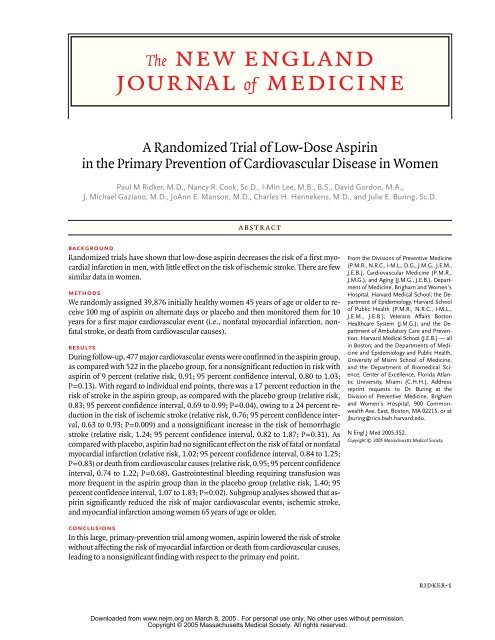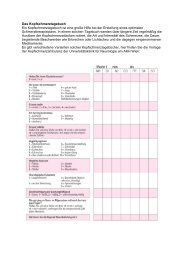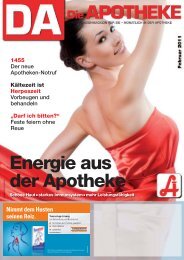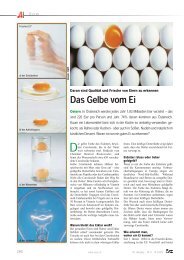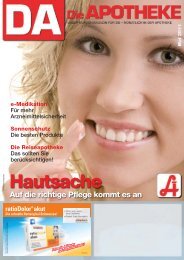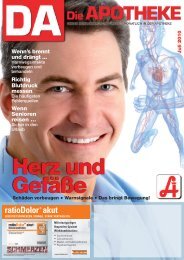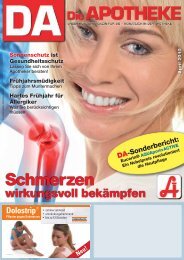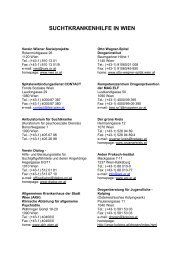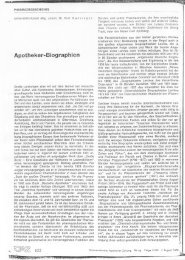The new england journal of medicine
The new england journal of medicine
The new england journal of medicine
You also want an ePaper? Increase the reach of your titles
YUMPU automatically turns print PDFs into web optimized ePapers that Google loves.
<strong>The</strong> <strong>new</strong> <strong>england</strong><br />
<strong>journal</strong> <strong>of</strong> <strong>medicine</strong><br />
established in 1812<br />
n engl j med 352;13<br />
march<br />
31,<br />
2005<br />
www.nejm.org march 31, 2005<br />
vol. 352 no. 13<br />
A Randomized Trial <strong>of</strong> Low-Dose Aspirin<br />
in the Primary Prevention <strong>of</strong> Cardiovascular Disease in Women<br />
Paul M Ridker, M.D., Nancy R. Cook, Sc.D., I-Min Lee, M.B., B.S., David Gordon, M.A.,<br />
J. Michael Gaziano, M.D., JoAnn E. Manson, M.D., Charles H. Hennekens, M.D., and Julie E. Buring, Sc.D.<br />
abstract<br />
background<br />
Randomized trials have shown that low-dose aspirin decreases the risk <strong>of</strong> a first myocardial<br />
infarction in men, with little effect on the risk <strong>of</strong> ischemic stroke. <strong>The</strong>re are few<br />
similar data in women.<br />
methods<br />
We randomly assigned 39,876 initially healthy women 45 years <strong>of</strong> age or older to receive<br />
100 mg <strong>of</strong> aspirin on alternate days or placebo and then monitored them for 10<br />
years for a first major cardiovascular event (i.e., nonfatal myocardial infarction, nonfatal<br />
stroke, or death from cardiovascular causes).<br />
results<br />
During follow-up, 477 major cardiovascular events were confirmed in the aspirin group,<br />
as compared with 522 in the placebo group, for a nonsignificant reduction in risk with<br />
aspirin <strong>of</strong> 9 percent (relative risk, 0.91; 95 percent confidence interval, 0.80 to 1.03;<br />
P=0.13). With regard to individual end points, there was a 17 percent reduction in the<br />
risk <strong>of</strong> stroke in the aspirin group, as compared with the placebo group (relative risk,<br />
0.83; 95 percent confidence interval, 0.69 to 0.99; P=0.04), owing to a 24 percent reduction<br />
in the risk <strong>of</strong> ischemic stroke (relative risk, 0.76; 95 percent confidence interval,<br />
0.63 to 0.93; P=0.009) and a nonsignificant increase in the risk <strong>of</strong> hemorrhagic<br />
stroke (relative risk, 1.24; 95 percent confidence interval, 0.82 to 1.87; P=0.31). As<br />
compared with placebo, aspirin had no significant effect on the risk <strong>of</strong> fatal or nonfatal<br />
myocardial infarction (relative risk, 1.02; 95 percent confidence interval, 0.84 to 1.25;<br />
P=0.83) or death from cardiovascular causes (relative risk, 0.95; 95 percent confidence<br />
interval, 0.74 to 1.22; P=0.68). Gastrointestinal bleeding requiring transfusion was<br />
more frequent in the aspirin group than in the placebo group (relative risk, 1.40; 95<br />
percent confidence interval, 1.07 to 1.83; P=0.02). Subgroup analyses showed that aspirin<br />
significantly reduced the risk <strong>of</strong> major cardiovascular events, ischemic stroke,<br />
and myocardial infarction among women 65 years <strong>of</strong> age or older.<br />
conclusions<br />
In this large, primary-prevention trial among women, aspirin lowered the risk <strong>of</strong> stroke<br />
without affecting the risk <strong>of</strong> myocardial infarction or death from cardiovascular causes,<br />
leading to a nonsignificant finding with respect to the primary end point.<br />
From the Divisions <strong>of</strong> Preventive Medicine<br />
(P.M.R., N.R.C., I-M.L., D.G., J.M.G., J.E.M.,<br />
J.E.B.), Cardiovascular Medicine (P.M.R.,<br />
J.M.G.), and Aging (J.M.G., J.E.B.), Department<br />
<strong>of</strong> Medicine, Brigham and Women's<br />
Hospital, Harvard Medical School; the Department<br />
<strong>of</strong> Epidemiology, Harvard School<br />
<strong>of</strong> Public Health (P.M.R., N.R.C., I-M.L.,<br />
J.E.M., J.E.B.); Veterans Affairs Boston<br />
Healthcare System (J.M.G.); and the Department<br />
<strong>of</strong> Ambulatory Care and Prevention,<br />
Harvard Medical School (J.E.B.) — all<br />
in Boston; and the Departments <strong>of</strong> Medicine<br />
and Epidemiology and Public Health,<br />
University <strong>of</strong> Miami School <strong>of</strong> Medicine,<br />
and the Department <strong>of</strong> Biomedical Science,<br />
Center <strong>of</strong> Excellence, Florida Atlantic<br />
University, Miami (C.H.H.). Address<br />
reprint requests to Dr. Buring at the<br />
Division <strong>of</strong> Preventive Medicine, Brigham<br />
and Women’s Hospital, 900 Commonwealth<br />
Ave. East, Boston, MA 02215, or at<br />
jburing@rics.bwh.harvard.edu.<br />
N Engl J Med 2005;352.<br />
Copyright © 2005 Massachusetts Medical Society.<br />
Downloaded from www.nejm.org on March 8, 2005 . For personal use only. No other uses without permission.<br />
Copyright © 2005 Massachusetts Medical Society. All rights reserved.<br />
ridker-1
2-ridker<br />
a<br />
lthough aspirin is effective in<br />
the treatment <strong>of</strong> acute myocardial infarction<br />
and in the secondary prevention <strong>of</strong><br />
cardiovascular disease among both men and women,<br />
1 its use in primary prevention remains controversial.<br />
To date, five randomized trials involving<br />
55,580 participants have evaluated aspirin in the<br />
primary prevention <strong>of</strong> cardiovascular disease.<br />
aggregate, these trials indicate that, as compared<br />
with placebo, aspirin therapy was associated with a<br />
significant, 32 percent reduction in the risk <strong>of</strong> myocardial<br />
infarction, but the data on the risk <strong>of</strong> stroke<br />
and death from cardiovascular disease remain in-<br />
conclusive.<br />
7<br />
<strong>The</strong> <strong>new</strong> <strong>england</strong> <strong>journal</strong> <strong>of</strong> <strong>medicine</strong><br />
n engl j med 352;13<br />
2-6<br />
In<br />
Moreover, three <strong>of</strong> these trials evaluat-<br />
ed men exclusively, and fewer than 180 <strong>of</strong> the 2402<br />
vascular events occurred in women. Thus, at this<br />
time, the current recommendations for the use <strong>of</strong><br />
aspirin in primary prevention in women are based<br />
on limited direct data from women.<br />
8-10<br />
Direct evidence regarding the effects <strong>of</strong> aspirin<br />
in women is necessary because cardiovascular disease<br />
is the leading cause <strong>of</strong> death among both women<br />
and men. Direct evidence is also relevant because<br />
<strong>of</strong> the potential for sex-based differences in<br />
salicylate metabolism11<br />
and continuing uncertainty<br />
regarding the cardiovascular effects <strong>of</strong> hormone-<br />
replacement therapy.<br />
12<br />
Moreover, in addition to a<br />
paucity <strong>of</strong> data on women, the prophylactic use <strong>of</strong><br />
aspirin in both sexes has prompted concern owing<br />
to the potentially increased risk <strong>of</strong> hemorrhagic<br />
stroke.<br />
13<br />
This issue is particularly complex, since<br />
the relative proportion <strong>of</strong> stroke to myocardial infarction<br />
differs between women and men.<br />
We addressed these questions in the Women’s<br />
Health Study, a large randomized, double-blind, placebo-controlled<br />
trial <strong>of</strong> low-dose aspirin in the primary<br />
prevention <strong>of</strong> cardiovascular disease among<br />
39,876 apparently healthy women followed for a<br />
mean <strong>of</strong> 10 years for the major cardiovascular events<br />
<strong>of</strong> myocardial infarction, stroke, and death from cardiovascular<br />
causes.<br />
methods<br />
study design<br />
<strong>The</strong> Women’s Health Study is a two-by-two factorial<br />
trial evaluating the balance <strong>of</strong> risks and benefits<br />
<strong>of</strong> low-dose aspirin (100 mg every other day;<br />
Bayer HealthCare) and vitamin E (600 IU every<br />
other day; National Source Vitamin E Association),<br />
in the primary prevention <strong>of</strong> cardiovascular disease<br />
and cancer. <strong>The</strong> trial was designed to evaluate the<br />
lowest dose <strong>of</strong> aspirin that would have a cardiopro-<br />
tective effect, while minimizing gastrointestinal<br />
side effects through the use <strong>of</strong> a low dose and alternate-day<br />
administration. <strong>The</strong> design <strong>of</strong> the study<br />
has previously been described in detail.<br />
www.nejm.org march 31,<br />
2005<br />
14,15<br />
In brief,<br />
between September 1992 and May 1995, letters <strong>of</strong><br />
invitation were mailed to more than 1.7 million female<br />
health pr<strong>of</strong>essionals. A total <strong>of</strong> 453,787 completed<br />
the questionnaires, with 65,169 initially willing<br />
and eligible to enroll. Women were eligible if<br />
they were 45 years <strong>of</strong> age or older; had no history<br />
<strong>of</strong> coronary heart disease, cerebrovascular disease,<br />
cancer (except nonmelanoma skin cancer), or other<br />
major chronic illness; had no history <strong>of</strong> side effects<br />
to any <strong>of</strong> the study medications; were not taking aspirin<br />
or nonsteroidal antiinflammatory medications<br />
(NSAIDs) more than once a week (or were willing<br />
to forego their use during the trial); were not taking<br />
anticoagulants or corticosteroids; and were not taking<br />
individual supplements <strong>of</strong> vitamin A, E, or beta<br />
carotene more than once a week. For the purposes<br />
<strong>of</strong> this study, inhibitors <strong>of</strong> cyclooxygenase, whether<br />
selective or nonselective, were considered to be<br />
NSAIDs.<br />
Eligible women were enrolled in a three-month<br />
run-in period <strong>of</strong> placebo administration to identify<br />
a group likely to be compliant with long-term treatment.<br />
A total <strong>of</strong> 39,876 women were willing, eligible,<br />
and compliant during the run-in period and underwent<br />
randomization: 19,934 were assigned to<br />
receive aspirin and 19,942 to receive placebo. Written<br />
informed consent was obtained from all participants.<br />
<strong>The</strong> trial was approved by the institutional<br />
review board <strong>of</strong> Brigham and Women’s Hospital,<br />
Boston, and was monitored by an external data and<br />
safety monitoring board.<br />
Every 12 months, the women were sent a year’s<br />
supply <strong>of</strong> monthly calendar packs containing active<br />
agents or placebo as well as questionnaires on<br />
compliance, side effects, the occurrence <strong>of</strong> relevant<br />
clinical end points, and risk factors. Study medications<br />
and end-point ascertainment were continued<br />
in a blinded fashion through the scheduled end <strong>of</strong><br />
the trial (March 31, 2004). Follow-up and validation<br />
<strong>of</strong> reported end points were completed in February<br />
2005. Rates <strong>of</strong> follow-up with respect to morbidity<br />
and mortality were 97.2 percent complete and 99.4<br />
percent complete, respectively.<br />
All the women were followed for myocardial infarction,<br />
stroke, or death from cardiovascular causes.<br />
Medical records were obtained for all women in<br />
whom a cardiovascular end point was reported to<br />
occur and were reviewed in a blinded fashion by<br />
an end-points committee <strong>of</strong> physicians. Myocardial<br />
Downloaded from www.nejm.org on March 8, 2005 . For personal use only. No other uses without permission.<br />
Copyright © 2005 Massachusetts Medical Society. All rights reserved.
low-dose aspirin and cardiovascular disease in women<br />
infarction was confirmed if symptoms met World<br />
Health Organization criteria and if the event was associated<br />
with abnormal levels <strong>of</strong> cardiac enzymes or<br />
diagnostic electrocardiograms. A confirmed stroke<br />
was defined as a <strong>new</strong> neurologic deficit <strong>of</strong> sudden<br />
onset that persisted for at least 24 hours. Clinical information,<br />
computed tomographic scans, and magnetic<br />
resonance images were used to distinguish<br />
hemorrhagic from ischemic events.<br />
16<br />
Death was<br />
confirmed to be from cardiovascular causes on the<br />
basis <strong>of</strong> an examination <strong>of</strong> autopsy reports, death<br />
certificates, medical records, and information obtained<br />
from the next <strong>of</strong> kin or other family members.<br />
<strong>The</strong> use <strong>of</strong> coronary revascularization (bypass<br />
surgery or percutaneous coronary angioplasty) was<br />
confirmed by a review <strong>of</strong> the medical records. A confirmed<br />
transient ischemic attack was defined as a<br />
neurologic deficit <strong>of</strong> sudden onset that lasted for<br />
less than 24 hours. Death from any cause was confirmed<br />
by the end-points committee or on the basis<br />
<strong>of</strong> a death certificate. Only confirmed end points<br />
were included in this analysis. For women with a<br />
reported myocardial infarction, the most common<br />
diagnoses among those in whom the diagnosis was<br />
not confirmed were stable or unstable angina or<br />
chest pain without evidence <strong>of</strong> infarction. For women<br />
with a reported stroke, the most common alternative<br />
diagnosis was transient cerebral ischemia.<br />
statistical analysis<br />
All primary analyses were performed on an intention-to-treat<br />
basis. <strong>The</strong> primary end point was a<br />
combination <strong>of</strong> major cardiovascular events, including<br />
nonfatal myocardial infarction, nonfatal<br />
stroke, and death from cardiovascular causes, and<br />
the trial was initially designed to have a statistical<br />
power <strong>of</strong> 86 percent to detect a 25 percent reduction<br />
in this end point. Secondary end points included<br />
the individual end points <strong>of</strong> fatal or nonfatal myocardial<br />
infarction, fatal or nonfatal stroke, ischemic<br />
stroke, hemorrhagic stroke, and death from cardiovascular<br />
causes. Additional analyses included the<br />
incidence <strong>of</strong> death from any cause, transient ischemic<br />
attack, and the need for coronary revascularization.<br />
If more than one end point occurred in a<br />
given woman, only the first event within each category<br />
was counted; for the primary combined end<br />
point, the first event in each woman was counted.<br />
Cox proportional-hazards models were used to<br />
calculate relative risks and 95 percent confidence<br />
intervals for the comparison <strong>of</strong> event rates in the aspirin<br />
and placebo groups after adjustment for age<br />
n engl j med 352;13<br />
and other randomized treatment assignments (vitamin<br />
E and beta carotene, which was a component<br />
<strong>of</strong> the trial for a median <strong>of</strong> 2.1 years17).<br />
Prespecified<br />
subgroup analyses were performed according to<br />
the presence or absence <strong>of</strong> major cardiovascular<br />
risk factors. Modification <strong>of</strong> the effect <strong>of</strong> aspirin<br />
by the risk factors was assessed with the use <strong>of</strong> interaction<br />
terms between subgroup indicators and<br />
aspirin assignment, with tests for trend performed<br />
when subgroup categories were ordinal. To examine<br />
effects among women who were compliant,<br />
we performed a sensitivity analysis in which follow-up<br />
data were censored at the time a woman reported<br />
having taken less than two thirds <strong>of</strong> the<br />
study medication during the previous year. In additional<br />
analyses, data were censored on women<br />
if and when they started taking NSAIDs more than<br />
three times a month.<br />
www.nejm.org march 31, 2005<br />
results<br />
primary analyses<br />
As shown in Table 1, the aspirin and placebo groups<br />
were similar with respect to baseline characteristics.<br />
<strong>The</strong> average duration <strong>of</strong> follow-up from randomization<br />
to the end <strong>of</strong> the trial was 10.1 years<br />
(range, 8.2 to 10.9). At the completion <strong>of</strong> the trial,<br />
999 women had had a first major cardiovascular<br />
event (Table 2), for an absolute event rate <strong>of</strong> 253 per<br />
100,000 person-years. Of these women, 477 were<br />
in the aspirin group and 522 were in the placebo<br />
group, indicating that there was a nonsignificant<br />
reduction in risk <strong>of</strong> 9 percent (relative risk, 0.91; 95<br />
percent confidence interval, 0.80 to 1.03; P=0.13).<br />
Regarding individual end points, women in<br />
the aspirin group had a 17 percent reduction in<br />
the risk <strong>of</strong> stroke (relative risk, 0.83; 95 percent<br />
confidence interval, 0.69 to 0.99; P=0.04), as compared<br />
with women in the placebo group; a 24 percent<br />
reduction in the risk <strong>of</strong> ischemic stroke (relative<br />
risk, 0.76; 95 percent confidence interval,<br />
0.63 to 0.93; P=0.009); and a nonsignificant increase<br />
in the risk <strong>of</strong> hemorrhagic stroke (relative<br />
risk, 1.24; 95 percent confidence interval, 0.82 to<br />
1.87; P=0.31) (Table 2). <strong>The</strong>re was no significant<br />
difference between the groups in the risk <strong>of</strong> fatal<br />
stroke (relative risk in the aspirin group, 1.04; 95<br />
percent confidence interval, 0.58 to 1.86; P=0.90),<br />
but the aspirin group had a decreased risk <strong>of</strong> nonfatal<br />
strokes (relative risk, 0.81; 95 percent confidence<br />
interval, 0.67 to 0.97; P=0.02), as compared<br />
with the placebo group.<br />
Downloaded from www.nejm.org on March 8, 2005 . For personal use only. No other uses without permission.<br />
Copyright © 2005 Massachusetts Medical Society. All rights reserved.<br />
ridker-3
4-ridker<br />
Table 1. Baseline Characteristics <strong>of</strong> the Women.*<br />
<strong>The</strong>re was no evidence that, as compared with<br />
placebo, aspirin reduced the overall risk <strong>of</strong> myocardial<br />
infarction (relative risk, 1.02; 95 percent confidence<br />
interval, 0.84 to 1.25; P=0.83), fatal myocardial<br />
infarction (relative risk, 1.16; 95 percent<br />
confidence interval, 0.54 to 2.51; P=0.70), nonfatal<br />
myocardial infarction (relative risk, 1.01; 95 percent<br />
confidence interval, 0.83 to 1.24; P=0.90), or<br />
death from cardiovascular causes (relative risk,<br />
0.95; 95 percent confidence interval, 0.74 to 1.22;<br />
P=0.68). However, aspirin therapy was associated<br />
with a 22 percent reduction in the risk <strong>of</strong> transient<br />
ischemic attack (relative risk, 0.78; 95 percent confidence<br />
interval, 0.64 to 0.94; P=0.01), with no significant<br />
effects on the risk <strong>of</strong> coronary revascularization<br />
(relative risk, 1.04; 95 percent confidence<br />
interval, 0.90 to 1.20; P=0.61) or death from any<br />
cause (relative risk, 0.95; 95 percent confidence interval,<br />
0.85 to 1.06; P=0.32).<br />
Figures 1 and 2 present the cumulative inci-<br />
<strong>The</strong> <strong>new</strong> <strong>england</strong> <strong>journal</strong> <strong>of</strong> <strong>medicine</strong><br />
Characteristic Aspirin (N=19,934) Placebo (N=19,942) Total (N=39,876)<br />
Age<br />
Mean ±SD (yr) 54.6±7.0 54.6±7.0 54.6±7.0<br />
45–54 yr (%) 60.2 60.2 60.2<br />
55–64 yr (%) 29.5 29.5 29.5<br />
≥65 yr (%)<br />
Smoking status (%)<br />
10.3 10.3 10.3<br />
Current 13.0 13.3 13.1<br />
Past or never<br />
Body-mass index*<br />
87.0 86.7 86.9<br />
Mean ±SD 26.1±5.1 26.0±5.0 26.0±5.1<br />
Table 1. (Continued.)<br />
low-dose aspirin and cardiovascular disease in women<br />
Characteristic Aspirin (N=19,934) Placebo (N=19,942) Total (N=39,876)<br />
Hyperlipidemia (%)§<br />
Yes 29.9 29.1 29.5<br />
No<br />
Diabetes (%)<br />
70.1 70.9 70.5<br />
Yes 2.7 2.5 2.6<br />
No<br />
Parental history <strong>of</strong> myocardial infarction<br />
before 60 yr <strong>of</strong> age (%)<br />
97.3 97.5 97.4<br />
Yes 13.0 12.9 12.9<br />
No<br />
10-yr risk <strong>of</strong> coronary heart disease (%)¶<br />
87.0 87.1 87.1<br />
Cumulative Incidence <strong>of</strong> Major Cardiovascular Events<br />
0.03<br />
0.02<br />
0.01<br />
6-ridker<br />
(Table 3). We observed a greater benefit <strong>of</strong> aspirin<br />
on the risk <strong>of</strong> major cardiovascular events among<br />
former smokers and those who had never smoked,<br />
with an apparent increased risk among current<br />
smokers (P for interaction
Cumulative Incidence<br />
<strong>of</strong> Stroke<br />
Cumulative Incidence<br />
<strong>of</strong> Ischemic Stroke<br />
0.02<br />
0.01<br />
low-dose aspirin and cardiovascular disease in women<br />
P=0.04<br />
0.00<br />
0 2 4 6 8 10<br />
Years <strong>of</strong> Follow-up<br />
0.02<br />
0.01<br />
0.00<br />
0 2 4 6 8 10<br />
Years <strong>of</strong> Follow-up<br />
ocardial infarction, consistent benefits <strong>of</strong> aspirin<br />
were observed among the subgroup <strong>of</strong> women<br />
who were 65 years <strong>of</strong> age or older. We found no evidence<br />
that menopausal status, the use or nonuse<br />
<strong>of</strong> hormone-replacement therapy after menopause,<br />
or global cardiovascular-risk status modified the<br />
effect <strong>of</strong> aspirin. As expected, the frequency <strong>of</strong> side<br />
effects related to bleeding and ulcers was increased<br />
among women who received aspirin.<br />
Our findings must be interpreted in the context<br />
<strong>of</strong> those <strong>of</strong> other completed, randomized trials <strong>of</strong><br />
aspirin in the primary and secondary prevention <strong>of</strong><br />
cardiovascular disease. In secondary prevention, the<br />
Antithrombotic Trialists’ Collaboration showed that<br />
aspirin clearly reduced the risk <strong>of</strong> cardiovascular<br />
events, myocardial infarction, and ischemic stroke<br />
in both men and women.<br />
1<br />
P=0.009<br />
Figure 2. Cumulative Incidence Rates <strong>of</strong> Stroke, Myocardial Infarction, Ischemic Stroke, and Hemorrhagic Stroke.<br />
To address the effects<br />
<strong>of</strong> aspirin in primary prevention, we performed a<br />
random-effects meta-analysis that included current<br />
data from the Women’s Health Study, as well as<br />
data from five prior trials involving 55,580 partici-<br />
pants with no history <strong>of</strong> heart disease.<br />
Placebo<br />
Aspirin<br />
Placebo<br />
Aspirin<br />
2-6,21<br />
n engl j med 352;13<br />
Over-<br />
all, as compared with placebo, aspirin therapy significantly<br />
reduced the risk <strong>of</strong> myocardial infarction<br />
Cumulative Incidence<br />
<strong>of</strong> Myocardial Infarction<br />
Cumulative Incidence<br />
<strong>of</strong> Hemorrhagic Stroke<br />
(relative risk, 0.76; 95 percent confidence interval,<br />
0.62 to 0.95; P=0.01) but had no significant<br />
effect on the risk <strong>of</strong> stroke (relative risk, 0.97; 95<br />
percent confidence interval, 0.83 to 1.13; P=0.69).<br />
In analyses stratified according to sex (Fig. 3), combined<br />
data on women from the Women’s Health<br />
Study, the Hypertension Optimal Treatment (HOT)<br />
study,<br />
5,21<br />
www.nejm.org march 31, 2005<br />
and the Primary Prevention Project<br />
6<br />
(and<br />
Roncaglioni MC: personal communication) indicate<br />
that aspirin therapy was associated with a significant,<br />
19 percent reduction in the risk <strong>of</strong> stroke<br />
(relative risk, 0.81; 95 percent confidence interval,<br />
0.69 to 0.96; P=0.01), with no reduction in the risk<br />
<strong>of</strong> myocardial infarction (relative risk, 0.99; 95<br />
percent confidence interval, 0.83 to 1.19; P=0.95).<br />
By contrast, the aggregate data on men from the<br />
Physicians’ Health Study, 2 the British Doctors’<br />
Trial, 3 the Thrombosis Prevention Trial, 4 the HOT<br />
study,<br />
0.02<br />
0.01<br />
P=0.83<br />
0.00<br />
0 2 4 6 8 10<br />
Years <strong>of</strong> Follow-up<br />
0.02<br />
0.01<br />
5,21<br />
P=0.31<br />
Aspirin<br />
Placebo<br />
0.00<br />
Aspirin<br />
Placebo<br />
0 2 4 6 8 10<br />
Years <strong>of</strong> Follow-up<br />
and the Primary Prevention Project<br />
6<br />
indi-<br />
cate that aspirin therapy was associated with a significant,<br />
32 percent reduction in the risk <strong>of</strong> myocardial<br />
infarction (relative risk, 0.68; 95 percent<br />
confidence interval, 0.54 to 0.86; P=0.001) and a<br />
nonsignificant increase in the risk <strong>of</strong> stroke (rela-<br />
Downloaded from www.nejm.org on March 8, 2005 . For personal use only. No other uses without permission.<br />
Copyright © 2005 Massachusetts Medical Society. All rights reserved.<br />
ridker-7
Table 3. Incidence and Relative Risk <strong>of</strong> Cardiovascular Events, According to Baseline Characteristics.*<br />
Group Total No. Major CV Event Stroke Ischemic Stroke Myocardial Infarction<br />
RR P<br />
RR P<br />
RR P<br />
RR P<br />
Asp Pla (95% CI) Value Asp Pla (95% CI) Value Asp Pla (95% CI) Value Asp Pla (95% CI) Value<br />
no. no. no. no.<br />
Age<br />
45–54 yr 24,025 163 161 1.01 (0.81–1.26) 0.92 77 90 0.85 (0.63–1.16) 0.31 57 71 0.80 (0.57–1.14) 0.21 69 56 1.23 (0.87–1.75) 0.25<br />
55–64 yr 11,754 183 186 0.98 (0.80–1.20) 0.84 76 90 0.84 (0.62–1.14) 0.26 60 75 0.80 (0.57–1.12) 0.19 88 75 1.17 (0.86–1.59) 0.32<br />
≥65 yr 4,097 131 175 0.74 (0.59–0.92) 0.008 68 86 0.78 (0.57–1.08) 0.13 53 75 0.70 (0.49–1.00) 0.05 41 62 0.66 (0.44–0.97) 0.04<br />
Smoking status<br />
Current 5,235 157 127 1.30 (1.03–1.64) 0.03 63 58 1.14 (0.80–1.63) 0.48 50 46 1.14 (0.76–1.70) 0.52 76 53 1.50 (1.06–2.13) 0.02<br />
Past or never 34,605 319 392 0.80 (0.69–0.93) 0.003 157 207 0.75 (0.61–0.92) 0.006 119 174 0.67 (0.53–0.85) 0.001 122 139 0.87 (0.68–1.10) 0.25<br />
8-ridker<br />
Body-mass index†<br />
Hyperlipidemia§<br />
Yes 11,745 183 227 0.80 (0.66–0.97) 0.02 75 119 0.62 (0.47–0.83) 0.001 67 98 0.68 (0.50–0.93) 0.01 92 88 1.03 (0.77–1.39) 0.82<br />
No 28,115 294 295 0.98 (0.84–1.16) 0.84 146 147 0.99 (0.78–1.24) 0.9 103 123 0.83 (0.64–1.08) 0.16 106 105 1.00 (0.77–1.31) 0.99<br />
Diabetes<br />
Yes 1,027 58 62 0.9 (0.63–1.29) 0.57 15 31 0.46 (0.25–0.85) 0.01 13 29 0.42 (0.22–0.82) 0.01 36 24 1.48 (0.88–2.49) 0.14<br />
low-dose aspirin and cardiovascular disease in women<br />
No 38,825 418 460 0.9 (0.79–1.03) 0.13 206 235 0.87 (0.72–1.05) 0.15 157 192 0.81 (0.66–1.00) 0.05 162 169 0.96 (0.77–1.18) 0.68<br />
Parental history <strong>of</strong> MI<br />
before 60 yr <strong>of</strong> age<br />
Yes 4,633 61 74 0.86 (0.61–1.21) 0.39 23 32 0.74 (0.43–1.26) 0.27 19 27 0.73 (0.41–1.31) 0.29 31 37 0.89 (0.55–1.43) 0.62<br />
No 31,210 355 388 0.90 (0.78–1.04) 0.16 170 206 0.82 (0.67–1.00) 0.05 130 170 0.75 (0.60–0.95) 0.02 141 136 1.03 (0.81–1.30) 0.82<br />
10-yr risk <strong>of</strong> CHD¶<br />
10-ridker<br />
Table 4. Incidence and Relative Risk <strong>of</strong> Side Effects. *<br />
Side Effect<br />
tive risk, 1.13; 95 percent confidence interval, 0.96<br />
to 1.33; P=0.15). <strong>The</strong> differences between men<br />
and women were significant at the P=0.01 level for<br />
myocardial infarction and at the P=0.005 level for<br />
stroke.<br />
<strong>The</strong> reasons for any sex-based differences in the<br />
efficacy <strong>of</strong> aspirin for primary prevention are unclear<br />
and require further exploration. Although the<br />
observed reductions in the risk <strong>of</strong> stroke could be<br />
due to chance, the reduced risk <strong>of</strong> transient ischemic<br />
attack associated with aspirin therapy adds<br />
support to the possibility <strong>of</strong> a causal interpretation.<br />
We cannot rule out the possibility that our null finding<br />
for the risk <strong>of</strong> myocardial infarction in women<br />
was due to an insufficient dose <strong>of</strong> aspirin or to the<br />
alternate-day regimen. However, we believe these<br />
explanations to be unlikely for three reasons.<br />
First, we have previously shown that the dose <strong>of</strong><br />
100 mg every other day used in the Women’s<br />
Health Study reduces thromboxane levels by 93 percent<br />
and prostacyclin levels by 85 percent and that<br />
these effects are similar in men and women.<br />
Second, in the HOT study, a 75-mg daily dose <strong>of</strong><br />
aspirin significantly lowered the risk <strong>of</strong> myocardial<br />
infarction overall, with a 42 percent reduction<br />
in the risk among men but a far smaller and<br />
nonsignificant reduction among women.<br />
<strong>The</strong> <strong>new</strong> <strong>england</strong> <strong>journal</strong> <strong>of</strong> <strong>medicine</strong><br />
* <strong>The</strong> presence <strong>of</strong> gastrointestinal bleeding or peptic ulcer was confirmed by a specific follow-up questionnaire. CI denotes<br />
confidence interval.<br />
21<br />
n engl j med 352;13<br />
22<br />
Third,<br />
since the dose and alternate-day regimen <strong>of</strong> aspirin<br />
used in our study were adequate to lower the risk <strong>of</strong><br />
stroke, it is unlikely that any hypothesized sexbased<br />
differences in the resistance to aspirin were<br />
at play overall. However, resistance to aspirin may<br />
be more prevalent among smokers,<br />
Aspirin<br />
(N=19,934)<br />
23<br />
and this re-<br />
sistance may have played some role in the increased<br />
risk with aspirin observed among current<br />
Placebo<br />
(N=19,942)<br />
smokers. We also believe it unlikely that a reduction<br />
in the efficacy <strong>of</strong> aspirin over time is a viable<br />
explanation, since the cumulative incidence data<br />
presented in Figures 1 and 2 <strong>of</strong>fer no support for<br />
this hypothesis. Furthermore, suboptimal compliance<br />
is an unlikely explanation, since aspirin did not<br />
decrease the risk <strong>of</strong> myocardial infarction among<br />
women with high rates <strong>of</strong> compliance — an observation<br />
again in contrast to data on stroke among<br />
the same women.<br />
With regard to daily clinical practice, our data<br />
demonstrate that aspirin therapy was associated<br />
with a net reduction in the risk <strong>of</strong> stroke among<br />
women, with a reduction in the risk <strong>of</strong> the far more<br />
common ischemic stroke and an increase in the risk<br />
<strong>of</strong> hemorrhagic stroke. This observation is particularly<br />
relevant, since as compared with men, women<br />
have a relatively greater proportion <strong>of</strong> strokes<br />
than <strong>of</strong> myocardial infarctions. Among women in<br />
the placebo group, there were more strokes than<br />
myocardial infarctions (266 vs. 193), and thus, the<br />
ratio <strong>of</strong> incident strokes to incident myocardial infarctions<br />
was 1.4:1, as compared with the ratio <strong>of</strong><br />
0.4:1 among men in the Physicians’ Health Study.<br />
From a policy perspective, our findings clearly demonstrate<br />
the importance <strong>of</strong> studying women as well<br />
as men in major cardiovascular clinical trials.<br />
An interesting finding in our subgroup analyses<br />
was that the most consistent benefit <strong>of</strong> aspirin was<br />
observed among women 65 years <strong>of</strong> age or older.<br />
This group <strong>of</strong> 4097 women composed 10 percent<br />
<strong>of</strong> the study population yet had almost one third <strong>of</strong><br />
the cardiovascular events. In this group, aspirin<br />
use, as compared with placebo use, led to 44 fewer<br />
myocardial infarctions, strokes, or deaths from car-<br />
www.nejm.org march 31,<br />
2005<br />
Relative Risk<br />
(95% CI) P Value<br />
no. <strong>of</strong> events (%)<br />
Gastrointestinal bleeding<br />
Any 910 (4.6) 751 (3.8) 1.22 (1.10–1.34)
BDT, 1988<br />
PHS, 1989<br />
TPT, 1998<br />
HOT, 1998<br />
low-dose aspirin and cardiovascular disease in women<br />
Trial Relative Risk <strong>of</strong> Myocardial Infarction<br />
among Men<br />
PPP, 2001<br />
RR=0.68 (0.54–0.86)<br />
P=0.001<br />
Combined<br />
0.2 0.5 1.0 2.0 5.0<br />
Aspirin Better Placebo Better<br />
HOT, 1998<br />
PPP, 2001<br />
WHS, 2005<br />
Trial Relative Risk <strong>of</strong> Myocardial Infarction<br />
among Women<br />
RR=0.99 (0.83–1.19)<br />
P=0.95<br />
Combined<br />
0.2 0.5 1.0 2.0 5.0<br />
Aspirin Better Placebo Better<br />
Figure 3. Aspirin in the Primary Prevention <strong>of</strong> Myocardial Infarction and Stroke among Men and Women.<br />
<strong>The</strong> results <strong>of</strong> a sex-specific random-effects meta-analysis <strong>of</strong> data from six trials are shown: the British Doctors’ Trial<br />
(BDT), the Physicians’ Health Study (PHS), the Thrombosis Prevention Trial (TPT), the Hypertension Optimal Treatment<br />
(HOT) study, the Primary Prevention Project (PPP), and the current Women’s Health Study (WHS). <strong>The</strong> relative risk (RR)<br />
and 95 percent confidence interval (in parentheses) are shown for each trial (indicated by the box and horizontal line<br />
through each box, respectively), and the relative risk is shown for the combined results (indicated by the diamond and<br />
the dashed line in each graph). For the relative risk <strong>of</strong> myocardial infarction among women, the dashed line is coincident<br />
with the solid line at 1.00. <strong>The</strong> size <strong>of</strong> the box is proportional to the amount <strong>of</strong> information in the corresponding trial.<br />
diovascular causes (P=0.008) but to 16 more gastrointestinal<br />
hemorrhages requiring transfusion<br />
(P=0.05), emphasizing, as with any agent, the importance<br />
<strong>of</strong> balancing benefits and risks. This agebased<br />
difference deserves further investigation.<br />
With respect to guidelines in primary prevention,<br />
in 2002, the Preventive Services Task Force24<br />
and the American Heart Association<br />
9<br />
recommend-<br />
ed aspirin for adults whose 10-year risks <strong>of</strong> a first<br />
coronary-heart-disease event were at least 6 percent<br />
and 10 percent, respectively. However, this may be<br />
complex for women, since in our study overall, aspirin<br />
lowered the risk <strong>of</strong> stroke without affecting<br />
the risk <strong>of</strong> myocardial infarction or death from cardiovascular<br />
causes. Thus, as with men, any decision<br />
about the use <strong>of</strong> aspirin in primary prevention<br />
n engl j med 352;13<br />
BDT, 1988<br />
PHS, 1989<br />
TPT, 1998<br />
HOT, 1998<br />
PPP, 2001<br />
Combined<br />
HOT, 1998<br />
PPP, 2001<br />
WHS, 2005<br />
Combined<br />
Trial Relative Risk <strong>of</strong> Stroke among Men<br />
RR=1.13 (0.96–1.33)<br />
P=0.15<br />
among women must ultimately be made after a<br />
woman consults her physician or health care provider,<br />
so that the net absolute benefits and risks for<br />
the individual patient can be ascertained.<br />
Supported by grants (HL-43851 and CA-47988) from the National<br />
Heart, Lung, and Blood Institute and the National Cancer Institute,<br />
Bethesda, Md. Aspirin and aspirin placebo were provided by<br />
Bayer HealthCare. Vitamin E and vitamin E placebo were provided<br />
by the Natural Source Vitamin E Association.<br />
Dr. Ridker reports having received grant support from Bayer. Dr.<br />
Cook reports having served as a consultant to Bayer. Dr. Gaziano reports<br />
having served as a consultant to, and receiving grant support<br />
from, Bayer and McNeil. Dr. Hennekens reports having served as a<br />
consultant to Bayer and McNeil and receiving grant support from<br />
Bayer.<br />
We are indebted to the 39,876 participants in the Women’s Health<br />
Study for their dedicated and conscientious collaboration; to the entire<br />
staff <strong>of</strong> the Women’s Health Study, under the leadership <strong>of</strong> David<br />
Gordon, Maria Andrade, Susan Burt, Mary Breen, Marilyn Chown,<br />
www.nejm.org march 31, 2005<br />
0.2 0.5 1.0 2.0 5.0<br />
Aspirin Better Placebo Better<br />
Trial Relative Risk <strong>of</strong> Stroke among Women<br />
RR=0.81 (0.69–0.96)<br />
P=0.01<br />
0.2 0.5 1.0 2.0 5.0<br />
Aspirin Better Placebo Better<br />
Downloaded from www.nejm.org on March 8, 2005 . For personal use only. No other uses without permission.<br />
Copyright © 2005 Massachusetts Medical Society. All rights reserved.<br />
ridker-11
12-ridker<br />
low-dose aspirin and cardiovascular disease in women<br />
Lisa Fields-Johnson, Georgina Friedenberg, Inge Judge, Jean Mac-<br />
Fadyen, Geneva McNair, Laura Pestana, David Potter, Philomena<br />
Quinn, Claire Ridge, Fred Schwerin, and Harriet Samuelson; to<br />
Christine Albert, Michelle Albert, Gavin Blake, Claudia Chae, Wendy<br />
n engl j med 352;13<br />
Chen, Richard Doll, Carlos Kase, Tobias Kurth, Richard Peto, Aruna<br />
Pradhan, Kathryn Rexrode, Bernard Rosner, and H. Jacqueline Suk<br />
for their assistance in the design and conduct <strong>of</strong> the trial; and especially<br />
to James Taylor for chairing the end-points committee.<br />
appendix<br />
Members <strong>of</strong> the data and safety monitoring board included L. Cohen, R. Collins, T. Colton, D. DeMets, I.C. Henderson, A. La Croix, R. Prentice,<br />
and N. Wenger (chair) and M.F. Cotch, F. Ferris, L. Friedman, P. Greenwald, N. Kurinij, M. Perl<strong>of</strong>f, E. Schron, and A. Zonderman (ex <strong>of</strong>ficio<br />
members).<br />
references<br />
1. Antithrombotic Trialists’ Collaboration.<br />
Collaborative meta-analysis <strong>of</strong> randomised<br />
trials <strong>of</strong> antiplatelet therapy for prevention<br />
<strong>of</strong> death, myocardial infarction, and stroke<br />
in high risk patients. BMJ 2002;324:71-86.<br />
[Erratum, BMJ 2002;324:141.]<br />
2. Steering Committee <strong>of</strong> the Physicians’<br />
Health Study Research Group. Final report<br />
on the aspirin component <strong>of</strong> the ongoing<br />
Physicians’ Health Study. N Engl J Med 1989;<br />
321:129-35.<br />
3. Peto R, Gray R, Collins R, et al. Randomised<br />
trial <strong>of</strong> prophylactic daily aspirin in<br />
British male doctors. Br Med J (Clin Res Ed)<br />
1988;296:313-6.<br />
4. <strong>The</strong> Medical Research Council’s General<br />
Practice Research Framework. Thrombosis<br />
prevention trial: randomised trial <strong>of</strong> lowintensity<br />
oral anticoagulation with warfarin<br />
and low-dose aspirin in the primary prevention<br />
<strong>of</strong> ischaemic heart disease in men at increased<br />
risk. Lancet 1998;351:233-41.<br />
5. Hansson L, Zanchetti A, Carruthers SG,<br />
et al. Effects <strong>of</strong> intensive blood-pressure lowering<br />
and low-dose aspirin in patients with<br />
hypertension: principal results <strong>of</strong> the Hypertension<br />
Optimal Treatment (HOT) randomised<br />
trial. Lancet 1998;351:1755-62.<br />
6. Collaborative Group <strong>of</strong> the Primary Prevention<br />
Project. Low-dose aspirin and vitamin<br />
E in people at cardiovascular risk: a<br />
randomised trial in general practice. Lancet<br />
2001;357:89-95. [Erratum, Lancet 2001;357:<br />
1134.]<br />
7. Eidelman RS, Hebert PR, Weisman SE,<br />
Hennekens CH. An update on aspirin in the<br />
primary prevention <strong>of</strong> cardiovascular disease.<br />
Arch Intern Med 2003;163:2006-10.<br />
8. Hayden M, Pignone M, Phillips C, Mulrow<br />
C. Aspirin for the primary prevention <strong>of</strong><br />
cardiovascular events: a summary <strong>of</strong> the evidence<br />
for the U.S. Preventive Services Task<br />
Force. Ann Intern Med 2002;136:161-72.<br />
9. Pearson TA, Blair SN, Daniels SR, et al.<br />
AHA guidelines for primary prevention <strong>of</strong><br />
cardiovascular disease and stroke: 2002 update:<br />
consensus panel guide to comprehensive<br />
risk reduction for adult patients without<br />
coronary or other atherosclerotic vascular<br />
diseases. Circulation 2002;106:388-91.<br />
10. Mosca L, Appel LJ, Benjamin EJ, et al.<br />
Evidence-based guidelines for cardiovascular<br />
disease prevention in women. Circulation<br />
2004;109:672-93.<br />
11. Montgomery PR, Berger LG, Mitenko<br />
PA, Sitar DS. Salicylate metabolism: effects<br />
<strong>of</strong> age and sex in adults. Clin Pharmacol <strong>The</strong>r<br />
1986;39:571-6.<br />
12. Manson JE, Hsia J, Johnson KC, et al. Estrogen<br />
plus progestin and the risk <strong>of</strong> coronary<br />
heart disease. N Engl J Med 2003;349:<br />
523-34.<br />
13. Rodondi N, Bauer DC. Assessing the risk/<br />
benefit pr<strong>of</strong>ile before recommending aspirin<br />
for the primary prevention <strong>of</strong> cardiovascular<br />
events. Am J Med 2004;117:528-30.<br />
14. Buring JE, Hennekens CH. <strong>The</strong> Women’s<br />
Health Study: summary <strong>of</strong> the study design.<br />
J Myocardial Ischemia 1992;4:27-9.<br />
15. Rexrode KM, Lee IM, Cook NR, Hennekens<br />
CH, Buring JE. Baseline characteristics<br />
<strong>of</strong> participants in the Women’s Health Study.<br />
J Womens Health Gend Based Med 2000;9:<br />
19-27.<br />
16. Atiya M, Kurth T, Berger K, Buring JE,<br />
Kase CS. Interobserver agreement in the classification<br />
<strong>of</strong> stroke in the Women’s Health<br />
Study. Stroke 2003;34:565-7.<br />
17. Lee I-M, Cook NR, Manson JE, Buring<br />
JE, Hennekens CH. b-Carotene<br />
supplemen-<br />
www.nejm.org march 31,<br />
2005<br />
tation and incidence <strong>of</strong> cancer and cardiovascular<br />
disease: the Women’s Health Study.<br />
J Natl Cancer Inst 1999;91:2102-06.<br />
18. Pulcinelli FM, Pignatelli P, Celestini A,<br />
Riondino S, Gazzaniga PP, Violi F. Inhibition<br />
<strong>of</strong> platelet aggregation by aspirin progressively<br />
decreases in long-term treated patients.<br />
J Am Coll Cardiol 2004;43:979-84.<br />
19. Catella-Lawson F, Reilly MP, Kapoor SC,<br />
et al. Cyclooxygenase inhibitors and the antiplatelet<br />
effects <strong>of</strong> aspirin. N Engl J Med<br />
2001;345:1809-17.<br />
20. Kurth T, Glynn RJ, Walker AM, et al. Inhibition<br />
<strong>of</strong> clinical benefits <strong>of</strong> aspirin on<br />
first myocardial infarction by nonsteroidal<br />
antiinflammatory drugs. Circulation 2003;<br />
108:1191-5.<br />
21. Kjeldsen SE, Kolloch RE, Leonetti G, et<br />
al. Influence <strong>of</strong> gender and age on preventing<br />
cardiovascular disease by antihypertensive<br />
treatment and acetylsalicyclic acid: the<br />
HOT study. J Hypertens 2000;18:629-42.<br />
22. Ridker PM, Hennekens CH, T<strong>of</strong>ler GH,<br />
Lipinska I, Buring JE. Anti-platelet effects <strong>of</strong><br />
100 mg alternate day oral aspirin: a randomized,<br />
double-blind, placebo-controlled trial<br />
<strong>of</strong> regular and enteric coated formulations<br />
in men and women. J Cardiovasc Risk 1996;<br />
3:209-12.<br />
23. Sanderson S, Emery J, Baglin T, Kinmonth<br />
A-L. Narrative review: aspirin resistance<br />
and its clinical implications. Ann Intern<br />
Med 2005;142:370-80.<br />
24. Preventive Services Task Force. Aspirin<br />
for the primary prevention <strong>of</strong> cardiovascular<br />
events: Recommendation and rationale.<br />
Ann Intern Med 2002;136:157-60.<br />
Copyright © 2005 Massachusetts Medical Society.<br />
Downloaded from www.nejm.org on March 8, 2005 . For personal use only. No other uses without permission.<br />
Copyright © 2005 Massachusetts Medical Society. All rights reserved.


